Home
Plants
More
Fungi Pics
Fungi
Fungi are a diverse group of organisms that obtain food by direct
absorption of nutrients. Food is dissolved by enzymes that the fungi
excrete and then absorbed through cell walls. Together with bacteria,
fungi are responsible for the decay and decomposition of all organic
matter and are found wherever other forms of life exist. Some are
parasitic on living matter and cause serious plant and animal
diseases Fungi were traditionally classified as a division of
the plant kingdom. They were thought of as plants that have no stems
or leaves and that in the course of becoming food absorbers lost the
pigment chlorophyll. Most scientists today, however, view them as an
entirely separate group that evolved from unpigmented flagellates and
place them either in the protist kingdom or in their own kingdom,
according to the complexity of organization.
REPRODUCTION AND CLASSIFICATION
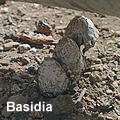 Spores
are usually formed in one of two ways. In one process the spores
form after the union of two or more nuclei within a specialized cell
or series of cells. These spores typically germinate into hyphae that
have different combinations of the hereditary characteristics of the
parent nuclei. The four types of spores that are produced in this
way-oospores, zygospores, ascospores, and basidiospores-are
representative of the four principal groups of fungi. Oospores are
formed by sexual union of a male and a female cell, zygospores by
conjugation of two similar sex cells.
Spores
are usually formed in one of two ways. In one process the spores
form after the union of two or more nuclei within a specialized cell
or series of cells. These spores typically germinate into hyphae that
have different combinations of the hereditary characteristics of the
parent nuclei. The four types of spores that are produced in this
way-oospores, zygospores, ascospores, and basidiospores-are
representative of the four principal groups of fungi. Oospores are
formed by sexual union of a male and a female cell, zygospores by
conjugation of two similar sex cells. 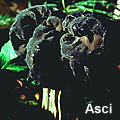 Ascospores
are spores (usually eight) that are contained in sacs (asci), and
basidiospores (usually four) are contained in clublike structures
(basidia). Included among the 25,000 species of this group are the
prized Morel and Truffle mushrooms
Ascospores
are spores (usually eight) that are contained in sacs (asci), and
basidiospores (usually four) are contained in clublike structures
(basidia). Included among the 25,000 species of this group are the
prized Morel and Truffle mushrooms
The other usual method of spore production involves the
transformation of hyphae into numerous short segments or into various
kinds of more complicated structures. Here, the fusion of two nuclei
is not a requirement. The principal reproductive spores formed in
this asexual manner include oidia, conidia, and sporangiospores.
Sporangiospores are formed inside bladderlike containers called
sporangia. Most fungi produce spores both sexually and asexually.
The Fifth group of Fungi are called "Imperfect Fungi"
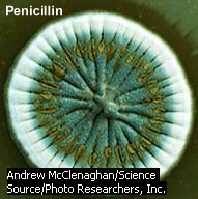 Around
25,000 additional fungus species are grouped in this phylum -- these
species are the "left-overs" that don't fit well into any
of the other groups. Members include Athlete's foot, Penicillin, and
"Yeast" infections.
Around
25,000 additional fungus species are grouped in this phylum -- these
species are the "left-overs" that don't fit well into any
of the other groups. Members include Athlete's foot, Penicillin, and
"Yeast" infections.
USES OF FUNGI
The hydrolytic enzymes of fungi are useful for a number of industrial
processes. When grown on steamed wheat bran or rice bran, one fungal
species produces an amylase product useful in alcoholic fermentation.
Proteases obtained from another fungus are used in the manufacture of
liquid glue. Commercial production of industrial ethyl alcohol is
accomplished by fermentation of sugarcane molasses or hydrolyzed
starch by means of enzymes formed by another fungus. In the process
of making bread, yeast is added to dough to produce carbon dioxide.
Fungus is used for the commercial production of citric acid and in
the production of gluconic acid and of gallic acid, which is used in
the manufacture of inks and dyes. Synthetic resins are manufactured
from fumaric acid formed by black bread mold (right). 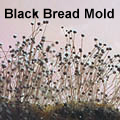 Gibberellic
acid, which promotes increased growth of plant cells, is formed by a
fungus causing disease in rice plants. Commercially usable oils have
been obtained from species of several genera, and one species is a
practical source of edible proteins. Vitamin D is prepared by
irradiation of ergosterol, a substance which may be obtained from the
waste brewer's yeast. A yeastlike fungus is a source of riboflavin,
and biotin accumulates during production of fumaric acid by another
fungus. Fungi are also used to produce Roquefort cheese and to ripen
Camembert cheese.
Gibberellic
acid, which promotes increased growth of plant cells, is formed by a
fungus causing disease in rice plants. Commercially usable oils have
been obtained from species of several genera, and one species is a
practical source of edible proteins. Vitamin D is prepared by
irradiation of ergosterol, a substance which may be obtained from the
waste brewer's yeast. A yeastlike fungus is a source of riboflavin,
and biotin accumulates during production of fumaric acid by another
fungus. Fungi are also used to produce Roquefort cheese and to ripen
Camembert cheese.
Fungi have been used medicinally since ancient times. The use of
fungi as a purgative is no longer prevalent, but the alkaloid in the
sclerotium of ergot still is used to produce uterine contractions in
childbirth. Ergot alkaloids are also a source of lysergic acid
diethylamide, commonly known as LSD, which produces hallucinogenic
effects, often of a severe nature. The use of antibiotics (see
Antibiotic) in medical practice dates from recognition of the
antibiotic properties of penicillin. Many antibiotics today are
produced by nonfungal microorganisms. Griseofulvin, however, is an
antifungal antibiotic formed by several species of a genus of fungi.
The immunosuppressant drugs cyclosporine and tacrolimus (FK-506),
both used in organ transplantation, are also derived from fungi.
Penicillin is an important antibiotic derived from the mold
Penicillum notatum, pictured here. Penicillin is effective against a
wide range of disease-causing bacteria. It acts by killing bacteria
directly or by inhibiting their growth.
Andrew McClenaghan/Science Source/Photo Researchers, Inc.
 The
plasmodial slime mold is a mucouslike plant that creeps along slowly
in leaf litter or over decaying logs. Although slime molds are
grouped together with plants, they are considered heterotrophic,
amoeboid organisms; that is, they lack photosynthetic ability and
must seek out foods that they can engulf and consume in an amoebalike
fashion. These primitive organisms feed on bacteria, fungal spores,
yeast cells, and decaying plant and animal matter.
The
plasmodial slime mold is a mucouslike plant that creeps along slowly
in leaf litter or over decaying logs. Although slime molds are
grouped together with plants, they are considered heterotrophic,
amoeboid organisms; that is, they lack photosynthetic ability and
must seek out foods that they can engulf and consume in an amoebalike
fashion. These primitive organisms feed on bacteria, fungal spores,
yeast cells, and decaying plant and animal matter.
M.P.L. Fogden/Oxford Scientific Films
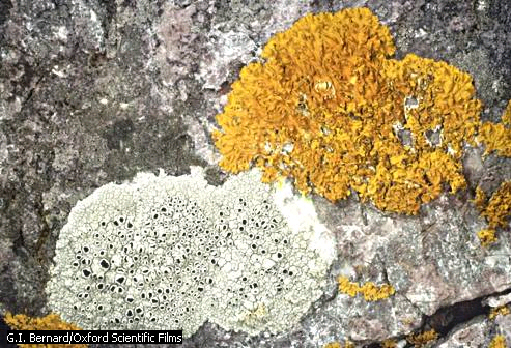 Lichens
are actually a combination of two entirely different types of living
organisms, an alga and a fungus. This association is called a
symbiotic relationship. In this particular type of symbiotic
relationship neither partner can live independent of the other.
Lichens are very slow growing and can survive very harsh
environmental conditions and are ecologically significant in that
they contribute to the weathering of solid rock.
Lichens
are actually a combination of two entirely different types of living
organisms, an alga and a fungus. This association is called a
symbiotic relationship. In this particular type of symbiotic
relationship neither partner can live independent of the other.
Lichens are very slow growing and can survive very harsh
environmental conditions and are ecologically significant in that
they contribute to the weathering of solid rock.
G.I. Bernard/Oxford Scientific Films
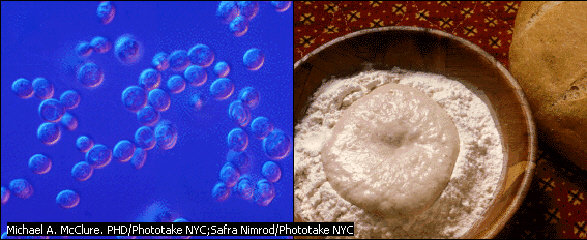
Bread yeast, Saccharomyces cerevisiae, or baker's yeast, a type of
fungi, reproduces by a process called budding. Bread yeast causes
bread to rise by releasing carbon dioxide, which gets trapped in the
dough. Here, microscopic yeast (left) have a macroscopic effect
(right) on bread dough.
Michael A. McClure. PHD/Phototake NYC;Safra Nimrod/Phototake NYC
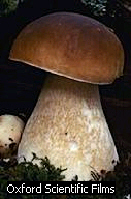
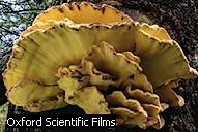 The
edible pore mushroom, or penny bun, is typically found in open
deciduous forests during the summer and early autumn months. Many
other related mushroom species are also edible.
The
edible pore mushroom, or penny bun, is typically found in open
deciduous forests during the summer and early autumn months. Many
other related mushroom species are also edible.
Oxford Scientific Films
The sulfur fungus is one of the largest of the edible fungi, reaching
a width of several meters and a weight of several kilograms. It is
also one of the most brilliantly colored of the fungi.
Oxford Scientific Films
For much more information go to:
http://www.perspective.com/nature/fungi/
 Spores
are usually formed in one of two ways. In one process the spores
form after the union of two or more nuclei within a specialized cell
or series of cells. These spores typically germinate into hyphae that
have different combinations of the hereditary characteristics of the
parent nuclei. The four types of spores that are produced in this
way-oospores, zygospores, ascospores, and basidiospores-are
representative of the four principal groups of fungi. Oospores are
formed by sexual union of a male and a female cell, zygospores by
conjugation of two similar sex cells.
Spores
are usually formed in one of two ways. In one process the spores
form after the union of two or more nuclei within a specialized cell
or series of cells. These spores typically germinate into hyphae that
have different combinations of the hereditary characteristics of the
parent nuclei. The four types of spores that are produced in this
way-oospores, zygospores, ascospores, and basidiospores-are
representative of the four principal groups of fungi. Oospores are
formed by sexual union of a male and a female cell, zygospores by
conjugation of two similar sex cells.  Ascospores
are spores (usually eight) that are contained in sacs (asci), and
basidiospores (usually four) are contained in clublike structures
(basidia). Included among the 25,000 species of this group are the
prized Morel and Truffle mushrooms
Ascospores
are spores (usually eight) that are contained in sacs (asci), and
basidiospores (usually four) are contained in clublike structures
(basidia). Included among the 25,000 species of this group are the
prized Morel and Truffle mushrooms Around
25,000 additional fungus species are grouped in this phylum -- these
species are the "left-overs" that don't fit well into any
of the other groups. Members include Athlete's foot, Penicillin, and
"Yeast" infections.
Around
25,000 additional fungus species are grouped in this phylum -- these
species are the "left-overs" that don't fit well into any
of the other groups. Members include Athlete's foot, Penicillin, and
"Yeast" infections. Gibberellic
acid, which promotes increased growth of plant cells, is formed by a
fungus causing disease in rice plants. Commercially usable oils have
been obtained from species of several genera, and one species is a
practical source of edible proteins. Vitamin D is prepared by
irradiation of ergosterol, a substance which may be obtained from the
waste brewer's yeast. A yeastlike fungus is a source of riboflavin,
and biotin accumulates during production of fumaric acid by another
fungus. Fungi are also used to produce Roquefort cheese and to ripen
Camembert cheese.
Gibberellic
acid, which promotes increased growth of plant cells, is formed by a
fungus causing disease in rice plants. Commercially usable oils have
been obtained from species of several genera, and one species is a
practical source of edible proteins. Vitamin D is prepared by
irradiation of ergosterol, a substance which may be obtained from the
waste brewer's yeast. A yeastlike fungus is a source of riboflavin,
and biotin accumulates during production of fumaric acid by another
fungus. Fungi are also used to produce Roquefort cheese and to ripen
Camembert cheese. The
plasmodial slime mold is a mucouslike plant that creeps along slowly
in leaf litter or over decaying logs. Although slime molds are
grouped together with plants, they are considered heterotrophic,
amoeboid organisms; that is, they lack photosynthetic ability and
must seek out foods that they can engulf and consume in an amoebalike
fashion. These primitive organisms feed on bacteria, fungal spores,
yeast cells, and decaying plant and animal matter.
The
plasmodial slime mold is a mucouslike plant that creeps along slowly
in leaf litter or over decaying logs. Although slime molds are
grouped together with plants, they are considered heterotrophic,
amoeboid organisms; that is, they lack photosynthetic ability and
must seek out foods that they can engulf and consume in an amoebalike
fashion. These primitive organisms feed on bacteria, fungal spores,
yeast cells, and decaying plant and animal matter. Lichens
are actually a combination of two entirely different types of living
organisms, an alga and a fungus. This association is called a
symbiotic relationship. In this particular type of symbiotic
relationship neither partner can live independent of the other.
Lichens are very slow growing and can survive very harsh
environmental conditions and are ecologically significant in that
they contribute to the weathering of solid rock.
Lichens
are actually a combination of two entirely different types of living
organisms, an alga and a fungus. This association is called a
symbiotic relationship. In this particular type of symbiotic
relationship neither partner can live independent of the other.
Lichens are very slow growing and can survive very harsh
environmental conditions and are ecologically significant in that
they contribute to the weathering of solid rock.

 The
edible pore mushroom, or penny bun, is typically found in open
deciduous forests during the summer and early autumn months. Many
other related mushroom species are also edible.
The
edible pore mushroom, or penny bun, is typically found in open
deciduous forests during the summer and early autumn months. Many
other related mushroom species are also edible.